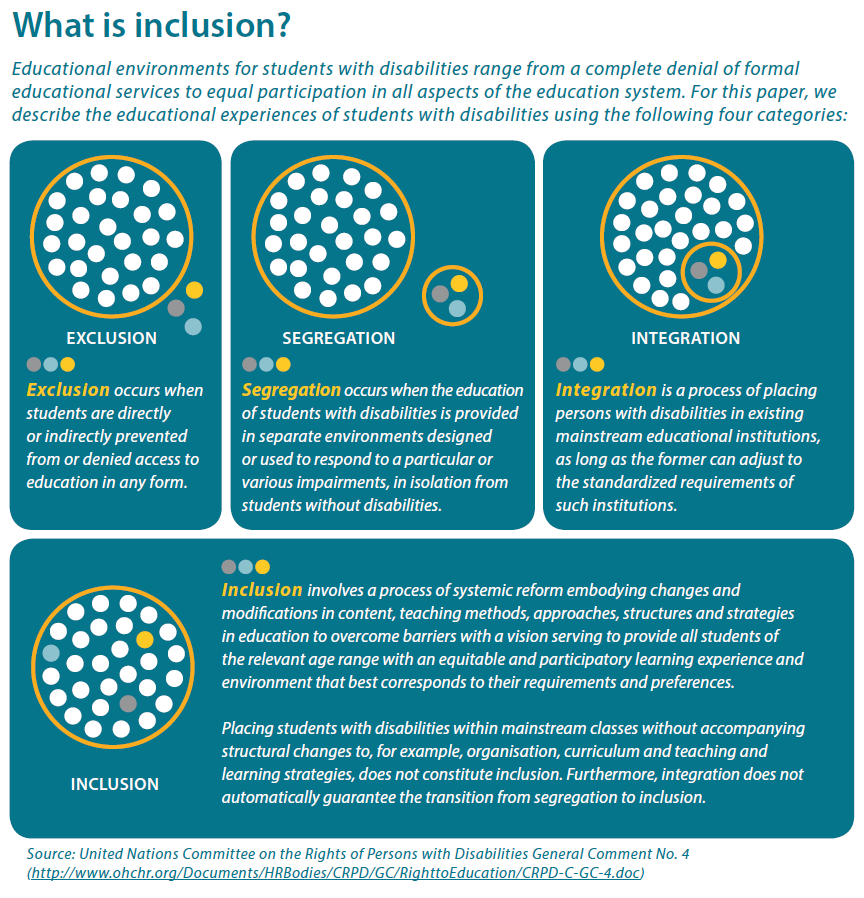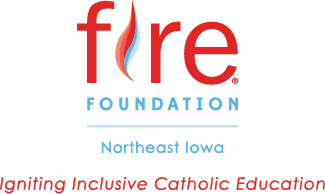What is Inclusion?
Inclusion is a learning approach in which all children, regardless of ability, learn together in the same school and classroom.
Dr. Michael Boyle describes the concept of inclusion with a metaphor from a Thanksgiving family meal table: “Our Catholic schools are tables. Some are invited to sit at the table and others are not. Sometimes, when those with disabilities are invited, they are only invited to the ‘kids’ table’, not in full participation at the ‘big table’. It is not enough just to be invited, as some small token. We must work to ensure that all have a place at the same table” (Ensuring a Place at the Table, NCEA, 2018).
Inclusion is an equitable and participatory learning experience:

At this time, inclusion programs at our Catholic schools are the exception rather than the norm. The FIRE Foundation of Northeast Iowa exists to create avenues and systems to ensure the opposite becomes reality–inclusion programs should be a common effort at all schools.
What We Do
FIRE NE Iowa makes grants to partner schools, providing partial funding for special education resources and staffing. Students with special needs achieve their individual academic objectives while learning alongside their peers. Our two FIRE pillars are funding and inclusive education advocacy.
Inclusion Resources
Inclusive Education Research
A Longitudinal Study to Determine the Impact of Inclusion on Student Academic Outcomes.
Sandi Cole, Indiana University (2019). Brief summary: Students with disabilities perform better on tests when they spend more time in general education classrooms.
The Dynamic Relationship Between Context, Curriculum, and Student Learning: A Case for Inclusive Education as a Research-based Practice.
Lewis B. Jackson, University of Northern Colorado (2010). Brief Summary: This article used theory, historical records, and empirical research to make a case that inclusive education, in which students experience significant proportions of their day in the age-appropriate contexts and curriculum of general education, is a research-based practice with students who have extensive support needs
A Preliminary Investigation of IEP Quality and Content Associated With Placement in General Education Versus Special Education.
Pam Hunt, (1992). Brief Summary: A significant increase was found in Individualized Education Plan (IEP) quality in measures of age appropriateness, functionality, and generalizations when students were moved from a self-contained classroom to a general education classroom. This was true even when the special educator stayed the same and moved with the child into the least restrictive environment. Experts interpret this to mean that there’s nothing going on within the four walls of a self-contained classroom that provides value and quality when stacked up against general education classroom settings.
Inclusive Schooling Practices: Pedagogical and Research Foundations. A synthesis of the literature that informs best practices about inclusive schooling.
G. McGregor, Allegheny University of the Health Sciences, (1998). Brief Summary: Many schools and parents make the argument that typical peers may be negatively impacted by the presence of students with disabilities. This study found that inclusion does NOT compromise a typical student’s academic or social outcome and in fact, typical students actually make more progress because of inclusionary practices.
Literature
Exceptional Learners White Paper: One Spirit, One Body.
Dr. Micheal Boyle, Andrew M. Greeley Center for Catholic Education, Loyola University Chicago School of Education.
Ensuring a Place at the Table: Serving Students with Disabilities in Catholic Schools.
Dr. Micheal Boyle (2018), National Catholic Educational Association.
Educational Programs
Andrew M. Greeley Center for Catholic Education,
Loyola University Chicago School of Education.
Notre Dame Program for Inclusive Education,
University of Notre Dame.
General Articles
- It’s time to end segregation of special education students, professors say ~ University of Kansas
- Building Inclusive Schools for Children of All Abilities, Nicole Eredics – June 12, 2015
- National Catholic Board on Full Inclusion
- More Catholic schools welcoming special needs students, Katie Scott, The Catholic Herald, January 28, 2016
- A Summary of the Evidence on Inclusive Education, Dr. Thomas Hehir, Silvana & Christopher Pasucci
The benefits of inclusive education are numerous for both students with and without special needs. Inclusion also gives Catholic learning communities a unique opportunity to live our faith by modeling Christ’s love for others.
Benefits of Inclusion for Students With Disabilities:
- Friendships
- Increased social initiations, relationships and networks
- Peer role models for academic, social and behavior skills
- Increased achievement of academic goals
- Increased opportunities to grow spiritually
- Opportunities to participate in sacramental development
- Greater access to general curriculum
- Enhanced skill acquisition and generalization
- Increased inclusion in future environments
- Greater opportunities for social interactions
- Higher expectations
- Increased school-staff-family collaboration
- Increased parent participation
- Families are more integrated into community
Benefits of Inclusion for Typical Students (without significant special needs):
- Meaningful friendships
- Increased appreciation and acceptance of individual differences
- Increased understanding and acceptance of diversity
- Respect for all people
- Opportunities to live the Catholic faith
- Prepares all students for adult life in an inclusive society
- Opportunities to master activities by practicing and teaching others
- Greater academic outcomes
- All students needs are better met when there are greater resources for all
